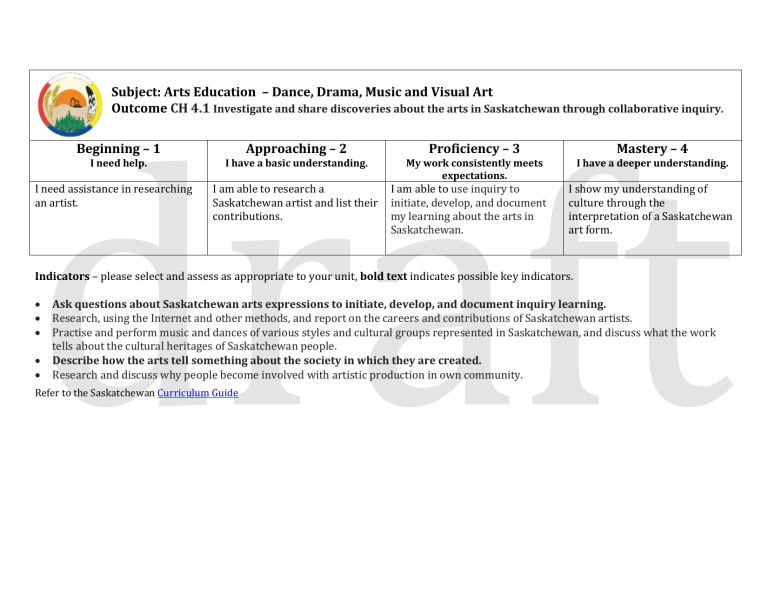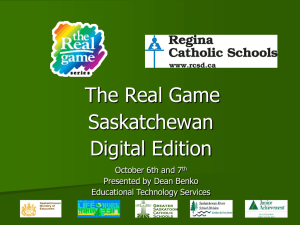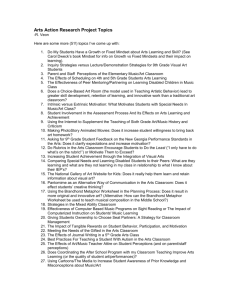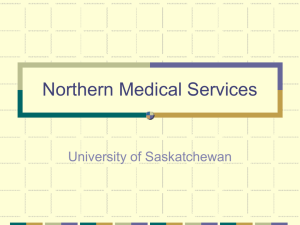Beginning – 1

Subject: Arts Education – Dance, Drama, Music and Visual Art
Outcome CH 4.1 Investigate and share discoveries about the arts in Saskatchewan through collaborative inquiry.
Beginning – 1
I need help.
I need assistance in researching an artist.
Approaching – 2
I have a basic understanding.
I am able to research a
Saskatchewan artist and list their contributions.
Proficiency – 3
My work consistently meets expectations.
I am able to use inquiry to initiate, develop, and document my learning about the arts in
Saskatchewan.
Mastery – 4
I have a deeper understanding.
I show my understanding of culture through the interpretation of a Saskatchewan art form.
Indicators – please select and assess as appropriate to your unit, bold text indicates possible key indicators.
Ask questions about Saskatchewan arts expressions to initiate, develop, and document inquiry learning.
Research, using the Internet and other methods, and report on the careers and contributions of Saskatchewan artists.
Practise and perform music and dances of various styles and cultural groups represented in Saskatchewan, and discuss what the work tells about the cultural heritages of Saskatchewan people.
Describe how the arts tell something about the society in which they are created.
Research and discuss why people become involved with artistic production in own community.
Refer to the Saskatchewan Curriculum Guide
Subject: Arts Education – Dance, Drama, Music and Visual Art
Outcome CH 4.2 Analyze and respond to arts expressions of various Saskatchewan First Nations and Métis artists.
Beginning – 1
I need help.
I need assistance identifying features of traditional art forms.
Approaching – 2
I have a basic understanding.
I am able to identify characteristics of First Nations and Métis art work.
Proficiency – 3
My work consistently meets expectations.
I am able to demonstrate awareness that arts expressions from different First Nations and
Métis often have strong foundations in traditional lifestyles and worldviews.
Mastery – 4
I have a deeper understanding.
I show a deeper understanding of ways that the arts relate to history and identity.
Indicators – please select and assess as appropriate to your unit, bold text indicates possible key indicators.
Demonstrate awareness that arts expressions from different First Nations often have strong foundations in traditional
lifestyles and worldviews.
Investigate, analyze, and describe features of traditional and evolving First Nations and Métis arts expressions.
Discuss the effects that unfulfilled treaty promises had, and continue to have, upon arts expressions and daily lives of First Nations people.
Refer to the Saskatchewan Curriculum Guide
Subject: Arts Education – Dance, Drama, Music and Visual Art
Outcome CR 4.1 Analyze how dance, drama, music, and visual art works represent unique ideas and perspectives.
Beginning – 1
I need help.
Approaching – 2
I have a basic understanding.
Proficiency – 3
My work consistently meets expectations.
Mastery – 4
I have a deeper understanding.
I need assistance identifying characteristics of an art form.
I can list characteristics of several art forms.
I can identify similarities between various art forms and identify the elements of art.
I can apply this understanding to an artwork of my own creation.
Indicators – please select and assess as appropriate to your unit, bold text indicates possible key indicators.
Discuss a variety of arts expressions comparing similarities.
Analyze and describe how various arts elements and techniques are applied in own and others’ arts expressions.
Evaluate how arts expressions reflect and affect the daily lives of people and apply this understanding in own work.
Refer to the Saskatchewan Curriculum Guide
Subject: Arts Education – Dance, Drama, Music and Visual Art
Outcome CR 4.2 Respond thoughtfully to a variety of contemporary Saskatchewan arts expressions.
Beginning – 1
I need help.
Approaching – 2
I have a basic understanding.
Proficiency – 3
My work consistently meets expectations.
Mastery – 4
I have a deeper understanding.
I need assistance to critique an art form.
I can view an art form and state a personal opinion.
I can respond to viewing an art form with a verbal or written critique and a physical interpretation of my own.
I show deeper understanding of the art form by connecting it other art forms in Saskatchewan.
Indicators – please select and assess as appropriate to your unit, bold text indicates possible key indicators.
Demonstrate critical and creative thinking when responding to dance, drama, music, and visual art expressions.
Express personal responses in various ways.
Describe why it is important to support opinions of arts expressions with reasons related to the work itself.
Assess the role and influence of the arts in own daily lives and communities.
Refer to the Saskatchewan Curriculum Guide
Subject: Arts Education – Dance
Outcome CP 4.1 Create dance compositions that express ideas about Saskatchewan using collaborative inquiry and movement problem solving.
Beginning – 1
I need help.
Approaching – 2
I have a basic understanding.
Proficiency – 3
My work consistently meets expectations.
Mastery – 4
I have a deeper understanding.
I need assistance with offering ideas to the group for the dance.
I am participate with the group and offer an idea of my own.
I am able to improvise and collaborate to create a dance composition to express an idea about Saskatchewan.
Indicators – please select and assess as appropriate to your unit, bold text indicates possible key indicators.
I can reflect on choices made for the dance and understand ways to improve the composition.
Collaborate on the creation of dance compositions using stimuli drawn from Saskatchewan sources such as local stories, personal experience, land and geography, feelings, memories, music, observation, imagination, or movement itself.
Select, or negotiate with other students, specific stimuli as starting points for dance compositions.
Use research, including guided Internet searches, as part of the dance-making process.
Improvise to generate and develop movement ideas.
Select movements from explorations, with increasing discernment, to create dance phrases.
Engage in movement problem solving, and sequence repeating and contrasting dance phrases.
Record dance and movement ideas in reflective records such as journals, drawings, or videos.
Appraise how own dance compositions have meaning and are unique expressions.
Reflect upon choices made during and after dance-making process.
Refer to the Saskatchewan Curriculum Guide
Subject: Arts Education – Dance
Outcome CP 4.2 Express ideas using the elements of dance including: actions (identify basic dance steps such as schottische, polka, grapevine, and step hop), body (body parts leading movements), dynamics (duration, speed, and force continuum), relationships (alone, partner, small groups), space (asymmetrical and symmetrical shapes,
creating and recalling pathways).
Beginning – 1
I need help.
I need assistance copying phrases as demonstrated.
Approaching – 2
I have a basic understanding.
I can copy phrases as demonstrated.
Proficiency – 3
My work consistently meets expectations.
I am able to identify and use the elements of dance to express ideas that show a wide range of movement.
Mastery – 4
I have a deeper understanding.
I am able to demonstrate a wide range of movements that show personal expression, strength and balance.
Indicators – please select and assess as appropriate to your unit, bold text indicates possible key indicators.
Identify and use the elements of dance to express ideas.
Demonstrate various ways that body parts may initiate a movement.
Explore and identify basic dance steps such as schottische, polka, grapevine, and step hop.
Copy movement phrases as demonstrated, and create own movement phrases.
Move with varying speeds, duration, and force.
Move expressively in time to different time signatures such as 4/4 and 3/4.
Create a variety of dance relationships, alone, with a partner, and in small groups.
Recognize that alignment means the relationship of body parts to each other, and practise proper alignment.
Create asymmetrical and symmetrical shapes in dance expressions.
Create and recall pathways on the floor and through the air.
Use a wide range of movements considering personal expression, strength, and balance.
Refer to the Saskatchewan Curriculum Guide
Subject: Arts Education – Drama
Outcome CP 4.3 Assume a range of roles and strategies in drama work, using a Saskatchewan context as
inspiration.
Beginning – 1
I need help.
Approaching – 2
I have a basic understanding.
Proficiency – 3
My work consistently meets expectations.
Mastery – 4
I have a deeper understanding.
I need assistance to listen and respond in role.
I can take on a role in the drama as directed by other people.
I am able to contribute ideas, respond and react to others with confidence in a variety of roles based on experiences of life in
Saskatchewan.
Indicators – please select and assess as appropriate to your unit, bold text indicates possible key indicators.
I am able to illustrate the connection between the drama and personal experiences.
Generate ideas for potential topics and dramatic contexts related to Saskatchewan sources such as local stories, personal experience, land and geography, observations, and current or historical events.
Sustain belief in own roles and the fictional situation of the drama.
Accept and respond imaginatively and thoughtfully to others in role.
Devise a variety of roles, improvisations, and dramatic episodes drawing on imagination and own observations and experiences of life in Saskatchewan.
Demonstrate confidence in using a variety of strategies within dramatic situations.
Use language purposefully when speaking and writing in role.
Reflect on, and discuss, how roles function within a drama.
Recall and respond to the drama work, both in and out of role.
Examine connections between personal experiences and own contributions to the work.
Refer to the Saskatchewan Curriculum Guide
Subject: Arts Education – Drama
Outcome CP 4.4 Contribute ideas, when in and out of role, and further the development of the drama by
participating in consensus building, choice of strategies, and selection of dramatic alternatives.
Beginning – 1
I need help.
Approaching – 2
I have a basic understanding.
Proficiency – 3
My work consistently meets expectations.
Mastery – 4
I have a deeper understanding.
I need assistance to listen and contribute to the group process.
I am able to listen to others and follow their lead in the drama.
I can contribute appropriately to the development of the drama by adding new information that builds tension or contrast while in role.
I use documentation of the drama to refine it with constructive feedback.
Indicators – please select and assess as appropriate to your unit, bold text indicates possible key indicators.
Use imagination when contributing ideas and when developing or extending the dramatic context.
Actively participate in an inquiry process in drama, asking questions, researching, and investigating dramatic possibilities arising from the questions.
Document the inquiry process in drama journals or other means.
Listen at all times within a drama and recognize the value of doing so.
Work co-operatively within dramatic contexts, demonstrate respect for the contributions of others, and appreciate the responsibilities and satisfaction of doing so.
Choose specific alternatives in order to further the drama’s development.
Build on new or surprise information as a way to make the drama more interesting.
Contribute to problem solving within the dramatic context.
Use research, including guided Internet searches, as part of drama work.
Refine and develop the drama through reflection and constructive feedback.
Refer to the Saskatchewan Curriculum Guide
Subject: Arts Education – Music
Outcome CP 4.5 Demonstrate increased skills and abilities in the use of voice and instruments (traditional and/or homemade) and develop compositions using Saskatchewan as inspiration.
Beginning – 1
I need help.
Approaching – 2
I have a basic understanding.
Proficiency – 3
My work consistently meets expectations.
Mastery – 4
I have a deeper understanding.
I need assistance to stay in tune and follow compositions.
I can sing in tune and follow compositions.
I can develop a sound composition, with voice and instrument, as inspired by my ideas about Saskatchewan.
I deeper understanding by analyzing the composition, solving problems, recognizing accidental discoveries and ways to best use them.
Indicators – please select and assess as appropriate to your unit, bold text indicates possible key indicators.
Sing in tune and begin to develop the ability to sing harmony.
Distinguish between the head voice and the chest voice in singing.
Recognize different voice classifications in singing and own voice qualities.
Sing expressively, using proper breath support, vowel sounds, consonants, and tone production.
Demonstrate increasing independence when playing various sound objects and instruments.
Experiment with sounds and music concepts to express ideas derived from Saskatchewan sources such as local stories, poems, visual art works, photos, land and geography, observations, and current or historical events.
Select and organize sounds, instruments, and ideas for composition.
Analyze and describe decisions made and problems solved in own and group compositions.
Keep a record of sound/music ideas.
Recognize accidental discoveries in own compositions and put them to use where appropriate.
Refer to the Saskatchewan Curriculum Guide
Subject: Arts Education – Music
Outcome CP 4.6 Create and perform music (voice and instrumental) that demonstrates knowledge of: form (e.g., round, call/ response, verse/chorus, rondo), rhythm, beat, and metre (e.g., triplets, 3/4 metre, syncopation; expressive use of tempo and dynamics), pitch, melody, and pentatonic scale (do, re, mi, sol, la, do), harmony and texture (e.g., layers of sound and patterns, partner songs), timbre (e.g., instrument classifications).
Beginning – 1
I need help.
Approaching – 2
I have a basic understanding.
Proficiency – 3
My work consistently meets expectations.
Mastery – 4
I have a deeper understanding.
I need assistance to identify common music forms.
I can identify common music forms.
I can play music (voice and instrumental) and identify the
I can manipulate the elements of music to create an expressive elements of musical form. composition.
Indicators – please select and assess as appropriate to your unit, bold text indicates possible key indicators.
Sing, play, and identify common music forms.
Investigate how the elements of music are used to establish form in music.
Ask questions to initiate inquiry into use of the elements and other music concepts under study.
Use research, including guided Internet searches, to investigate how professional composers use the elements of music and concepts currently under study.
Incorporate triplets and syncopation into own music compositions.
Investigate how tempo, dynamics, tone colour, and silence can be used expressively.
Investigate shape/contours of melody by exploring pitches and rhythms in songs and music, and arranging pitches and rhythms in own compositions.
Sing partner songs and experiment with layering two or more pitches to create harmony.
Investigate and analyze the arrangement of ascending and descending pitch patterns/scales.
Classify and distinguish between various instruments and their sound characteristics.
Refer to the Saskatchewan Curriculum Guide
Subject: Arts Education – Visual Art
Outcome CP 4.7 Create visual art works that express own ideas and draw on sources of inspiration from
Saskatchewan.
Beginning – 1
I need help.
Approaching – 2
I have a basic understanding.
Proficiency – 3
My work consistently meets expectations.
Mastery – 4
I have a deeper understanding.
I need assistance asking questions that lead to ideas.
I can recreate a picture about
Saskatchewan from the work of other artists.
I can use techniques of illusion to express ideas about the
Saskatchewan environment.
Indicators – please select and assess as appropriate to your unit, bold text indicates possible key indicators.
I can apply artistic conventions of other Saskatchewan artists into my own unique composition about Saskatachewan.
Pose questions about Saskatchewan and determine ways to investigate the questions individually and/or collectively through visual art.
Collaborate with other students to plan, document, and share the results of the visual art inquiry.
Use research, including guided Internet searches, as part of the inquiry process.
Discuss how artists are often influenced by cultural and artistic traditions, and consider incorporating heritage or artistic conventions in own work.
Create the illusion of three dimensions through drawing observations of the Saskatchewan environment.
Describe various sources of ideas for visual art such as memory, research, observation, feelings, or imagination.
Record ideas for visual art to use as research and inspiration for own work.
Recognize accidental discoveries in own work and put them to use, where appropriate.
Discuss how own art works express ideas about self and Saskatchewan in unique ways, and describe how problem solving and personal reflection are important parts of the creative process.
Refer to the Saskatchewan Curriculum Guide
Subject: Arts Education – Visual Art
Outcome CP 4.8 Create art works using a variety of visual art concepts (e.g., organic shapes), forms (e.g., kinetic
sculpture, mural), and media (e.g., wood, wire, and found objects).
Beginning – 1
I need help.
Approaching – 2
I have a basic understanding.
Proficiency – 3
My work consistently meets expectations.
Mastery – 4
I have a deeper understanding.
I need assistance using art tools and materials.
I recognize colours and relationships on the colour wheel.
I can create an art work that demonstrates an imaginative use of the elements of art and accurate visual perception.
I can demonstrate various strategies to accurately represent
3D qualities through 2D media.
Indicators – please select and assess as appropriate to your unit, bold text indicates possible key indicators.
Demonstrate imaginative use of the elements of art including line, colour, texture, shape, form, and space.
Recognize complementary colours as being opposite each other on the colour wheel.
Recognize analogous colours as those that share a common hue.
Create many different textures within various classifications.
Identify and use geometric and organic shapes and forms; symmetrical and asymmetrical shapes and forms.
Investigate the use and effects of formal and informal patterns, and create patterns through techniques such as repetition.
Demonstrate the ability to perceive visual details, and include details to enhance depictions of plants, animals, people, and objects.
Apply knowledge of size relationships in own drawings.
Investigate how the illusion of three dimensions is created through drawing.
Use contour lines to draw people, animals, and objects.
Demonstrate understanding that overlapping objects is a way to show their placement in space.
Analyze and reflect on own decision making about methods and materials.
Expand skills and abilities in using various visual art tools and materials.
Refer to the Saskatchewan Curriculum Guide





